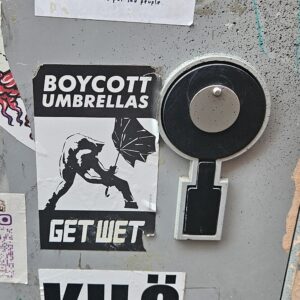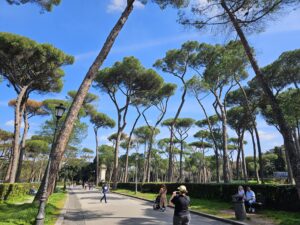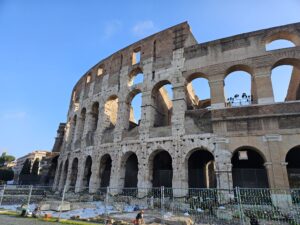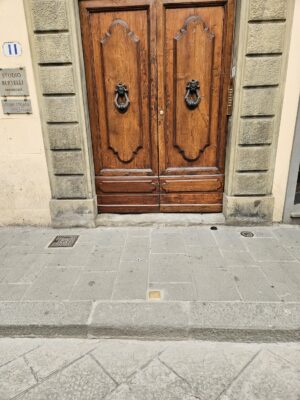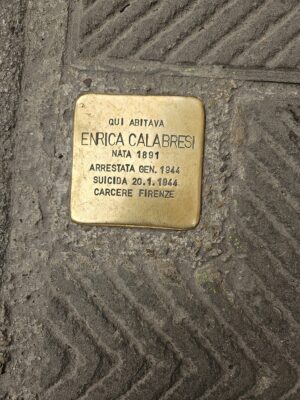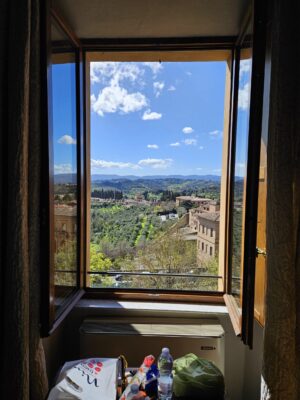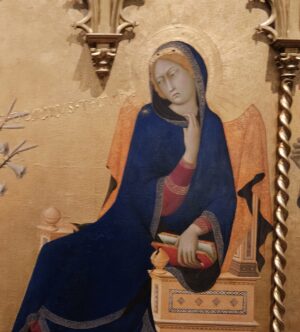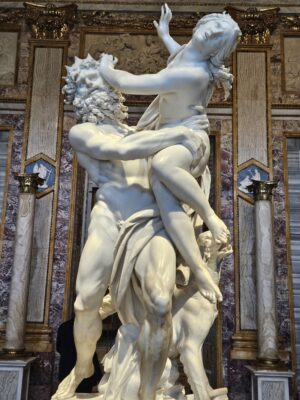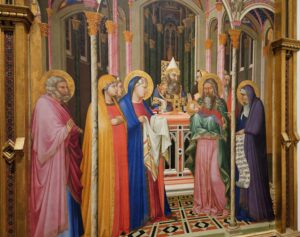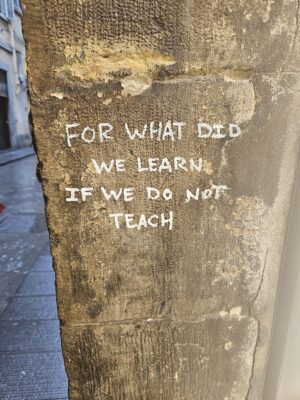When we walked into the second hall of the Uffizi, I think I audibly gasped.
All work from the 13th century, Cimabue and Giotto’s enormous wood panel paintings of Mary and the Christ child, and especially Duccio di Buoninsegna’s astonishing The Rucellai Madonna,. It does not loom over you. It encompasses you with its bright reds and umbers, its cerulean, and olive and a deep black robe that glimmers into ultramarine and so many more subtle shades whose names that I would have to continue to look up.
Its devotion, their devotion, for that’s the only word I can think of, their completely unironic devotion, staggered me.
Nothing but the eyes can do these paintings justice. Photographs diminish their colors and their spatial dominance. In their presence, they mean to inspire awe.
It has been that kind of trip. I can offer a partial list of those visits and sights we found to be wonderful and sometimes overwhelming: Bernini’s David and The Rape of Persephone; St. Peter’s Basilica; the slaughterhouse of the Colosseum; the grand space of the Piazza del Campo; Galileo’s instruments; the Explosion of the Cart on Easter morning in Florence; the Dying Gaul; the Villa Borghese Park, and its green parrots and umbrella pines.
This can only be a partial list. The more I remember those 15 days, the more I marvel.
Sitting here now I summon bits of the street art that popped up everywhere but also reminders of another kind of history, one of the Occupation and the Holocaust. I can see the understated elegance of so many Italians in their dress and movements. The food, the coffee, the wine, the street life, the supernatural skill of average Italian drivers in negotiating crowds and streets narrower than alleys.
Above everything though, the Italians we spoke with as guides and waiters and a family on a train and ordinary people in the streets – these were the treasures of the trip.
I loved our time in France* and all of our conversations there were pleasant, but the French also make a little fence beyond which they examine one with a cool detachment. Almost every Italian with whom we had conversations was all in, especially once we made a stumbling effort to speak the language. Their warmth was surprising and continually refreshing.
I have found that if I write down names, I can recall faces: Umber, our guide in Siena, a Milanese transplant who loved the Palio; Giovanni, whose encyclopedic recall of Michelangelo’s life and methods drew us deep into an awareness of the Sistine Chapel; Jonathan, the buoyant ex-paratrooper and historian of Tuscany and Nino, the funny bus driver who took us to wineries; Fulvio, the first of our Roman taxi drivers, a 4th generation Roman who spoke in the cadences of Zero Mostel; Giulia, the 20 year old waitress who spoke 6 languages and was takings degrees in economics and International Relations; Nina, a pierced, tattooed dual Irish-Italian with an Eritrean boyfriend; Ludovica, the bookseller, who clasped my hand when I told her of the bookstore where I worked in the States; Barberini, who stood with us in the rain with 10,000 others while we waited for the Explosion of the Cart at the Duomo Piazza; Samuela, who gave us the eyes to see in the Uffizi; the mothers with 4 children returning to their home in Messina who chattered with us using Google translate on our train ride from Florence back to Rome – Sonya, Salvatore, Alexandro, Samuel, Anna and Mia.
After 15 days in Rome, Florence and Siena, we are ready to return.
Not for the sights, the food, the coffee. Not for the rivers, the Tuscan hills, the wine, the trees. Not for the paintings, the statues, the winding streets, the pigeons, the blackbirds that sing like orioles. But for the Italians, this marvelous nation, this welcoming people.
I have begun my new lists of Italian words and sentences. When we return, I want to be something more than a mumbling, smiling American. These are a few from my Day 1 series:
Come ti chiami? What is your name?
Di dove sei? Where do you come from?
Qual è la tua storia? What is your story?
Amo questo posto! I love this place!
Look at the sidewalk in front of the door.
